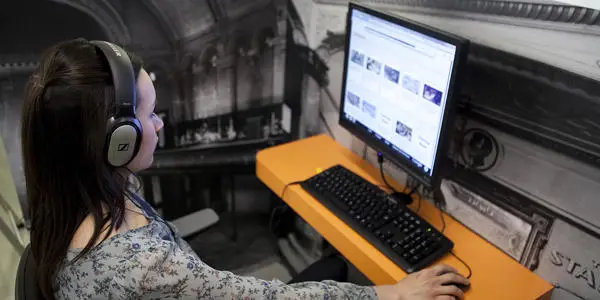Mediatheque
What is a Mediatheque?
The term 'Mediatheque' was first used during the 1980s, when broadcast material (audio and video recordings) was finally recognised as an important cultural testimony, in the same way as archives.
Today, there are numerous Mediatheque(s) across the UK and Western Europe. In the UK, for instance, the British Film Institute (BFI) has its own Mediatheque on the London Southbank site.

Our Mediatheque - image, film, sound
The Mediatheque provides on demand access to our films and to our extensive photographic series, maps and plans and oral histories.
While our image library, The London Picture Archive is available to browse from home, we felt that it was important to provide a point of focus for researchers who want access to all our sources on the visual history of the capital.

How is it arranged?
The Big Screen
Visitors can enjoy a film loop on the big screen which showcases our collections and beyond.
Digital Image, Film and Sound Collections
There are eight individual terminals to view and listen to content.
- Digital documents - A selection of almost 1000 archive documents including the charter of William the Conqueror in 1067.
- The London Picture Archive (Researcher) - Visitors can use this version of our image library to perform searches across some of our visual material such as photographs, prints and maps. This includes items which are not rights cleared and cannot be made available in the web version that you access from home.
- Films - This section contains those films available on our YouTube channel and others which are not rights cleared, so they cannot be made available publicly but are exclusively available to view here.
- Oral History - This section showcases oral history projects, including interviews with two members of staff employed at Peabody Estates in London in the early to mid-twentieth century, interviews with six ex-mariners, part of the Black Experience Archives Trust (BEAT)'s work and 'Whispers of Time: Memories of Migration and Settlement' - a collection of experiences of Chinese Londoners.
- Audio - A selection of audio recordings including those relating to Bogle L'Ouverture which was a publishing house founded in 1969 by Eric and Jessica Huntley, Guyanese-born political activists.
Exhibitions
- Exhibitions - An opportunity to see electronic versions of some of our previous exhibitions held in our onsite display area including 'Unforgotten Lives'.
Maps
- The London Picture Archive (Researcher) - a range of zoomable maps are available.
- Map drawers - access to a range of large facsimile maps documenting the geographical landscape of London over six centuries.
- Alan Godfrey maps - reprints of old Ordnance Survey (OS) maps for the Greater London area.
Reference material
Reference material is also available, including a small library of books.